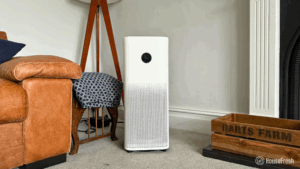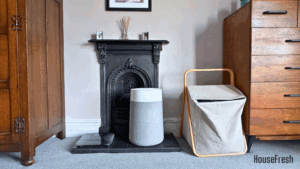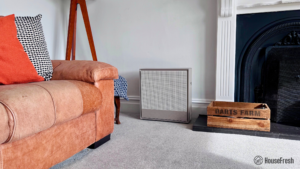Honeywell has been a trusted brand worldwide for a long while, and it’s easy to see why. They use their extensive engineering knowledge to design a variety of consumer products, including high-performance air purifiers.
We reviewed the Honeywell HPA300 two years ago and were impressed with its performance but not so happy with its running costs. With the Air Genius range, Honeywell has done something a little different by using a permanent/washable particle filter instead of one you need to replace periodically.
But does this filter stand up next to tried and tested HEPA technology? Has Honeywell given this the same power we’ve seen in previous models? Is it any good?
I will answer all these questions as I take you through every aspect of the Air Genius 5.
The lowdown on the Honeywell Air Genius 5 HFD320

“A washable filter seems like the perfect solution to avoid paying for costly filter replacements, but the technology is just not there yet.
A high initial price and poor particle removal performance make it hard to recommend the Honeywell Air Genius 5.”

Don’t have time to read my full review? Don’t worry, I’m not offended. Check out my concise list of what I liked about the Air Genius 5 and what I think could be better.
What we really like
What we think could be better
The specs
We’ve come to expect more from air purifiers over $250, and this unit doesn’t hit the mark for performance or smart features.
| HouseFresh rating: | ★★☆☆☆ |
| Time to clean our 728 cubic feet test room (with the device running at top speed): | 93 minutes |
| Air purifier technology: | True HEPA Filter K |
| Recommended room size (4.8 air changes per hour): | 250 sq. ft. |
| Clean air delivery rate (CADR): | Dust: 160 CFM Smoke: 161 CFM Pollen: 170 CFM |
| Dimensions (in inches / in cm): | 9.97 x 9.92 x 26.81 inches (25.3 x 25.2 x 68 cm) |
| Weight (in pounds / in kg): | 13.05 lbs (5.91 kg) |
| Filter life: | Pre-filter: 3 months ifD® particle filter: washable |
| Noise level in decibels (measured from 3 ft. away with a sound level meter): | Speed 1: 41.8 dB Speed 2: 44.8 dB Speed 3: 45.9 dB |
| Electricity consumption in watts (recorded with an electricity usage monitor): | Standby mode: 0 watts Speed 1: 26.11 watts Speed 2: 27.2 watts Speed 3: 28.83 watts Speed 4: 30.75 watts Speed 5: 35.12 watts |
| Estimated running cost (electricity consumption + official filter replacement): | $111.57 per year |
| Cost per CADR cfm (based on dust CFM as reported by AHAM): | $1.22 |
| Manufacturer’s warranty: | 5 years |
| Country of manufacture: | China |
Typical tower air purifier
It may not be groundbreaking, but Honeywell has designed clear, easy-to-use controls and a light feature.

Honeywell has an aesthetic they tend not to deviate from, which means you know what you’re gonna get when it comes to design. With its glossy black casing and large vented grill, the Air Genius 5 sticks to this trend…but in a tower format.

Don’t get me wrong, in the air purifier world, it’s no Elephant Man, but it’s also no [insert current attractive celebrity] either.
I feel that it’s time for Honeywell to take design into the new era, especially now that other manufacturers are releasing air purifiers with innovative and modern designs like the Airmega 150 from Coway and Levoit’s EverestAir.
But all is not lost, as Honeywell has added a little flare to the Air Genius 5 in the form of a blue accent light on the bottom of the unit.

This blue hue matches the color of the control buttons and gives the unit a futuristic look.

There are not a lot of buttons on the Air Genius 5, but they make use of the space by making them large and descriptive. Instead of ‘fan speed,’ it says ‘cleaning level’ where you can choose from [1] Sleep to [5] Max. There is also a timer you can set in 2-hour increments from 2 to 12 hours, turn on the oscillation and a button to illuminate the accent light.

Honeywell has also added something I’d like to see more of… a filter status gauge. This gives you an idea of how full of particles your filter is so you know when it’s time to clean it.
I really appreciated the quick access guide that comes with the Air Genius 5 to remind the user of what each of the modes does, as well as instructions to reset the filter replacement warning light.

In my view, the Air Genius 5 is lacking in smart functions. There is no auto mode, no sensors and no AQI (Air Quality Indicator). If you want/need your air purifier with extra features, you can upgrade to the Air Genius 6. But I wouldn’t recommend that as there are plenty of more powerful and cheaper units available.
Check out the TaoTronics TT-AP003, the Winix 5500-2 or the Levoit Core 300S for better performance for a fraction of the price.

Washable particle filter
It makes environmental sense to use a permanent filter, but the ifD® filter in this unit doesn’t show much promise.

Honeywell has opted for something a little different for the Air Genius range. Instead of using HEPA filters that need replacing periodically, they’ve installed a permanent, washable particle filter they call the ifD®.

ifD® (intense field dielectric) technology has been described as “light-years ahead of anything else out there.” Instead of using fibers to capture particles like in HEPA, these types of filters contain thin electrode sheets to generate electrical fields. When pollutants pass through, they become electrically charged, forcing them to be drawn to the filter’s surfaces.

As well as the ifD® filter, the Air Genius 5 has a separate ‘K Pre-Filter’ to trap larger particles like dust and dander. Honeywell claims this filter can also remove VOCs (Volatile Organic Compounds) and “odors from cooking, smoke, bathrooms and pets.”
In order to effectively remove odors and VOCs from the air, you need a substantial amount of activated carbon. The K Pre-Filter In this unit is a thin slice of material with little hope of removing odors and gasses. Sorry, Honeywell, that’s a poor effort.

When prompted by the filter check lights, you’ll need to remove the filter before you can wash it. Removing the filter is the easy part:
- Unplug your air purifier
- Detach the back panel
- Remove the filters
- Wash, leave to dry completely and put them back the same way
Here’s a quick video to show you how easy it is to remove and re-insert the filter.
Full washing instructions are printed on the side of the air purifier.

Filters are often wrapped in plastic and placed into the air purifier when bought new from the store. Always remember to remove all packaging from the filter before switching on your unit.
If you don’t remove this packaging, the filter will not operate correctly, and you’ll probably start to detect a burning smell coming from your new air purifier.
The Honeywell Air Genius 5 HFD320 cleared our test room in 93 minutes
Our air cleaning speed test showed subpar performance from a trusted brand.
The Honeywell Air Genius HFD320 was sent to the AHMA VERIFIDE program, which puts the device through a series of tests to see how well it performs at removing dust, pollen and smoke. Public results are available at the EnergyStar directory.

The dust CADR of 161 CFM would make me expect that it would be a little quicker than the Winix A230 (36 minutes) or the Taotronics AP 005 (36 minutes) as they have similar CADR scores. Based on this CADR rating, we would expect a result of around 36 minutes, give or take three minutes.
In order to get accurate data, we test every unit we review under the same conditions. We light an incense stick inside our 728 cubic ft. test room and use our trusted PurpleAir sensor to measure the levels of PM1.0, PM2.5, PM10 and VOCs while the air purifier is working at its highest fan speed. This allows us to see how quickly the device can clear smoke pollutants from the air in the room.

At its highest fan speed, the Air Genius 5 cleared our home lab of incense smoke in 93 minutes. This was a disappointing result, not only for an air purifier of this size and cost but also for a Honeywell unit, which prides itself on cleaning performance.
I am also surprised that the AHAM CADR score is so far off from the results we found in our in-house test. I tested this device again and got the same results, which were far from what we would expect based on the reported CADR from AHAM. It’s a little worrying as AHAM is the gold standard when evaluating air cleaners’ performance, but it shows us the importance of our in-house experiments.
Air cleaning performance results, compared
When you compare this performance to other air purifiers similar in size or cost, you see how this unit falls short.
Two air purifiers that spring to mind are the Levoit Core 300S and the Winix A231(A230). These units are over half the size, cost a lot less $$$ to buy, have more features like an auto mode, AQI and app connectivity (Core 300S only) and cleared our home lab of contaminants over 70 minutes faster than the Air Genius 5.
Other units that surpass the Air Genius 5 on performance to consider are the Winix 5500-2, Levoit Vital 200S, TaoTronics TT-AP003, Blueair Blue Pure 311, the list goes on.
Noise levels results, compared
I need to mention one positive that the Air Genius 5 has over many other units on the market: it is VERY quiet.
When you compare this to some of the other units we’ve tested, the Honeywell shows that you can be a larger unit and still make the same sound as a ninja on a mission.
As you cycle through its fan speeds, the noise created is barely noticeable. At its highest fan speed, the Air Genius 5 produces 46dB (comparable to a refrigerator running), and at its lowest, it only makes 42dB (comparable to light rainfall).
Sound is subjective, so here’s a video of me cycling through its five fan speeds so you can hear its output for yourself.
The cost to run a Honeywell Air Genius 5 HFD320: $111.57 per year
You save money not replacing the particle filter, but the pre-filter only lasts three months.
1. Electricity costs = $53.57 per year
Unfortunately, the costs of clean air don’t stop at the initial purchase of an air purifier. You need to run this electrical device, and that means energy costs. With the cost of energy continually on the rise, it pays to know a unit’s running costs (pun intended).
On paper, the Air Genius 5 comes across as a highly energy-efficient air purifier that should cost less than $60 a year to run. But, as we’ve seen from our performance tests, this is because it’s not exactly working as hard as other units out there.
2. Filter costs = $58 per year
Another consideration to factor into your budget is how much it costs to replace the filters when needed. This is where I usually talk about how HEPA filters need replacing periodically because of how they work, but the Air Genius 5 doesn’t use a HEPA filter.
Having a washable filter may require more effort than simply ordering a new one, but you save a heck of an amount of money over time. That would be true for the AG5 if the pre-filters lasted longer than 3 months.
Why have a washable particle filter but not a washable pre-filter?
At around $30 for a pack of two genuine Honeywell pre-filters, replacing them is the biggest expense here.
You can opt to buy unofficial filters from other brands at a cheaper price, but I can’t testify to how effective they are.
- NOTICE ***** PRE-FILTERS ARE DESIGNED TO BE LARGER THAN AND PROPERLY COVER THE HEPA FILTER. NOT TO COVER THE HOUSING GRILL. NO AIR WILL BYPASS THE PRE-FILTER. REFERENCE IMAGE #2
- DESIGNED TO FIT: Honeywell* Air Genius 3, 4, 5, 6 Air Purifier – Models HFD300, HFD310, HFD314, HFD320, HD320, HFD323CV1, HFD323-TGT, HFD324, HFD360B
- NO SCISSORS REQUIRED: Pre-Cut for Exact Fitment 5-3/4″ x 20-5/8″
- MADE IN USA: High Grade Powdered Activated Carbon for Superior Performance, Includes Resealable Bag To Maintain Carbon Freshness
- PERFORMACE: Proper balance of Air Flow and Performance
Bottom line
This is a poor-performing air purifier considering its price, I suggest you look elsewhere.
Honeywell has a strong position in the air purifier world. Their products are trusted and held in high regard amongst consumers. So, why have they let this one out into the wild?
There are some redeeming features on the Air Genius 5. It doesn’t look ugly, the controls are easy to use and it is seriously quiet, but none of these can outweigh the sheer lack of performance compared to its price tag.

I’ve never been this negative about an air purifier before, it’s probably because I’m so disappointed. I would expect this type of performance from a cheap mini-unit, not a tower unit from one of the best brands in the game.
Do yourself a favor, forget all about the Air Genius 5 and check out the long list of better air purifiers that we’ve tested and reviewed, like the Winix 5500-2, Levoit Vital 200S, TaoTronics TT-AP003, Blueair Blue Pure 311.
SOURCES
We calculated yearly costs associated with running the Honeywell Air Genius 5 HFD320 24 hours a day, 365 days per year utilizing the latest average energy prices as reported by the Bureau of Labor Statistics of $0.174/kWh as of May 2024.






